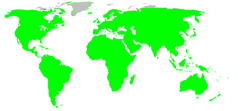| Tangle-web spiders Temporal range:
| |
|---|---|

| |
| Enoplognatha ovata | |
| Scientific classification | |
| Domain: | Eukaryota |
| Kingdom: | Animalia |
| Phylum: | Arthropoda |
| Subphylum: | Chelicerata |
| Class: | Arachnida |
| Order: | Araneae |
| Infraorder: | Araneomorphae |
| Family: | Theridiidae Sundevall, 1833 |
| Diversity | |
| 124 genera, 3028 species | |

| |
Theridiidae, also known as the tangle-web spiders, cobweb spiders and comb-footed spiders, is a large family of araneomorph spiders first described by Carl Jakob Sundevall in 1833.[1] This diverse, globally distributed family includes over 3,000 species in 124 genera,[2] and is the most common arthropod found in human dwellings throughout the world.[3]
Theridiid spiders are both entelegyne,[4] meaning that the females have a genital plate, and ecribellate, meaning that they spin sticky capture silk instead of woolly silk. They have a comb of serrated bristles (setae) on the tarsus of the fourth leg.
The family includes some model organisms for research, including the medically important widow spiders. They are important to studies characterizing their venom and its clinical manifestation, but widow spiders are also used in research on spider silk and sexual biology, including sexual cannibalism. Anelosimus are also model organisms, used for the study of sociality, because it has evolved frequently within the genus, allowing comparative studies across species, and because it contains species varying from solitary to permanently social.[5] These spiders are also a promising model for the study of inbreeding because all permanently social species are highly inbred.[6]
The Hawaiian Theridion grallator is used as a model to understand the selective forces and the genetic basis of color polymorphism within species. T. grallator is known as the "happyface" spider, as certain morphs have a pattern resembling a smiley face or a grinning clown face on their yellow body.[7][8]
- ^ Sundevall, C. J. (1833). Conspectus Arachnidum.
- ^ Cite error: The named reference
NMBEwas invoked but never defined (see the help page). - ^ Leong, Misha; et al. (2017). "The Habitats Humans Provide: Factors affecting the diversity and composition of arthropods in houses". Scientific Reports. 7 (15347): 15347. Bibcode:2017NatSR...715347L. doi:10.1038/s41598-017-15584-2. PMC 5681556. PMID 29127355.
- ^ Agnarsson, I. (2006). "Asymmetric female genitalia and other remarkable morphology in a new genus of cobweb spiders (Theridiidae, Araneae) from Madagascar". Biological Journal of the Linnean Society. 87 (2): 211–232. doi:10.1111/j.1095-8312.2006.00569.x.
- ^ Purcell, J.; Aviles, L. (2007). "Smaller colonies and more solitary living mark higher elevation populations of a social spider". Journal of Animal Ecology. 76 (3): 590–597. Bibcode:2007JAnEc..76..590P. doi:10.1111/j.1365-2656.2007.01228.x. PMID 17439475.
- ^ Agnarsson, I. (2006). "A revision of the New World eximius lineage of Anelosimus (Araneae, Theridiidae) and a phylogenetic analysis using worldwide exemplars" (PDF). Zoological Journal of the Linnean Society. 146 (4): 453–593. doi:10.1111/j.1096-3642.2006.00213.x. Archived from the original (PDF) on 2007-09-27.
- ^ Oxford, G.S.; Gillespie, R.G. (1996). "Quantum Shifts in the Genetic Control of a Colour Polymorphism in Theridion Grallator (Araneae: Theridiidae), the Hawaiian Happy-Face Spider". Heredity. 76 (3): 249–256. doi:10.1038/hdy.1996.38. S2CID 824014.
- ^ Gillespie, R.G.; Tabashnik, B.E. (1989). "What makes a happy face? Determinants of color pattern in the Hawaiian happy face spider Theridion grallator (Araneae, Theridiidae)". Heredity. 62 (3): 355–364. doi:10.1038/hdy.1989.50.